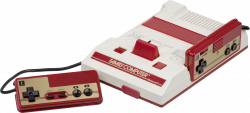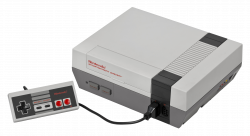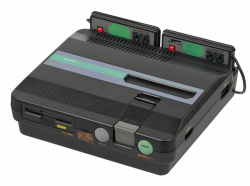NES:NES Model Differences
Some page content & researching collaboratively taken from io55.net's NES page with permission.
There are two NES models, and three minor/internal revisions for both of the models. For the Famicom there are four main models, with several revisions between them.
Models + Revisions
Models are arranged chronologically. Revisions are underneath their respective model.
HVC-001 (1983-1993)
Released on July 15, 1983, the Family Computer was Nintendo's first programmable game system, which quickly took the nascent Japanese video game market by storm. It is a rather small console with a white and red color scheme (though the white portion tends to turn yellow) and has two hardwired gamepads which are stored in integrated holsters on each side of the console. On the top is the cartridge slot which is covered by a flip-top flap, power switch, reset button, and a large spring-loaded lever which can eject an inserted cartridge. At the front is a 15-pin expansion port, typically used for external controllers. On most Famicom consoles, this port was kept covered by a red-colored cap which protected it from potential damage (and is usually missing on many examples). The RF out, DC input, channel and TV/game select switches are located in the rear. This basic design remained largely unchanged for a decade, though Nintendo made multiple revisions of the original Famicom throughout its life.
Older Famicom consoles can be easily discerned by their different controllers, which use square-shaped rubber B and A buttons, and are often known as "square button" Famicoms because of this. These consoles also tend to have smooth plastic for the bottom shell and cartridge flap, and sometimes have gray-colored controller cables instead of black. During 1984, the Famicom was subject to a recall over a buggy CPU, which had been used in all Famicoms up to that point. At the same time, Nintendo changed the controller design to use round B and A buttons made of hard plastic, which offered an improved feel and did not get stuck down, which the original square buttons tended to do.
HVC-CPU-01 through HVC-CPU-05 (1983-1984)
These are the original revisions of the Famicom and are perhaps the rarest of all revisions, as they were all used in the aforementioned "square button" Famicoms. What makes these particularly unique is that they use the original version of the 2A03 CPU, which was later recalled due to stability issues. The original 2A03 also does not support the "looped noise" function in its APU, so certain games like Mega Man 2, have a slightly different sound as a result. Due to timing differences, these are also incompatible with flash carts such as the EverDrive.
All of these boards use PPU revisions ranging from the original 2C02 to the 2C02E.
HVC-CPU-06 (1984)
This was the last board revision to feature the original CPU, and makes use of surface mount chips for both the CPU RAM and PPU RAM. Some boards use the "fixed" 2A03E CPU which also debuted alongside the revised "round button" controllers.
HVC-CPU-07 (1984-1988)
By far the most common of all Famicom revisions, as it was introduced around the time the console's popularity was skyrocketing. All of these boards use the 2A03E CPU and 2C02E PPU.
HVC-CPU-08 (1984)
A very rare variant of the CPU-07 board that has surface mount RAM chips instead of through-hole chips. It is otherwise identical to the CPU-07.
HVC-CPU-GPM-01/02 (1988-1993)
During 1988, Nintendo made the first major internal revision to the Famicom with the HVC-CPU-GPM-01 board. In order to meet VCCI (Japanese Voluntary Control Council for Interference) standards, the RF/power board was now directly soldered onto the motherboard (as opposed to being connected by a thin ribbon cable) and more extensive shielding was added, including a metal shroud over the cartridge connector. Beginning with this revision, Nintendo began adding the "FF" Famicom Family logo to the nameplate on the front, which acted in a similar fashion to the Nintendo Seal of Quality used outside Japan.
Introduced in 1989, the HVC-CPU-GPM-02 is mostly the same as the GPM-01, but has an added ceramic capacitor (C36) near the PPU and another added in between the two controller buffer chips. This was the final revision of the original Famicom and was produced all the way into 1993, until the original design was finally replaced by the AV Famicom.
NES-001/NESE-001 "Front Loader" (1985-1993)
On October 18, 1985, Nintendo brought over the Famicom to the West as the Nintendo Entertainment System, which helped to revitalize the American video game market and became a massive cultural icon. Though it uses the same basic hardware as the Famicom, Nintendo made a large number of cosmetic and functional changes in order to have the console appeal more to the American market, where many retailers had become wary of video game consoles in the wake of the 1983 market crash. The NES's 1985 release was only limited to New York City as a test market, and the console received a full North American release in the fall of 1986.
The Famicom's toylike look and small shape have given way to a more utilitarian and bulky form, which deliberately mimics a contemporary VCR. Cartridges are loaded into the front behind a flip-up door (hence the "front loader" nickname) and pushed down. The cartridges themselves were also redesigned with a much larger shape and have 72 pins instead of the Famicom's 60. Also along the front are the power and reset buttons, power LED, and two 7-pin controller ports. On the right-hand side are composite video and mono audio outputs, a rarity on game consoles of the time. At the rear are the RF output, channel select switch and AC adapter input. Though the NES lacks the Famicom's 15-pin expansion port, the NES has a much more extensive 48-pin expansion port located on the bottom of the console which ultimately went unused.
In order to prevent a glut of unauthorized games from appearing on the console, Nintendo also implemented a lockout system in the NES which the Famicom never had. This lockout system consists of two chips, with one in the NES acting as a "lock" and one in the game cartridge acting as the "key". If the cartridge is missing this "key" or if the chips do not match, the console will go into a reset loop and the game cannot be played. Nintendo used several different lockout chips depending on region; PAL regions were strangely given two different types, "PAL-A" and "PAL-B", with neither one being compatible with the other. This lockout scheme also prevents NTSC games from working on PAL consoles and vice versa.
The NES used the same design across all the regions in which it was released, and it largely remained unchanged throughout the years. Earlier consoles produced from 1985 to 1987 had smooth plastic on the top and bottom shells, while all later consoles use textured plastic.
Despite its popularity, the original NES is also infamous for its unreliability, largely caused by its unusual front-loading cartridge connector. If either the game or connector are even slightly dirty, or if the game isn't seated quite right, it can lead to problems such as the game not booting or graphics gradually becoming corrupted during gameplay. Various solutions have popped up for this over the years, ranging from simply cleaning the connector to outright replacement of the connector with aftermarket alternatives.
Detailed below are the various board revisions which the original NES received over its 8-year life. CPU, PPU, and RAM variants may impact game compatibility.
NES-CPU-01 through NES-CPU-04 (1985-1986)
May have video quality that is poorer than expected for the NES-001. Some of these, especially the early ones, may be prone to frequent errors and unreliable behavior.
NES-CPU-05 through NES-CPU-09 (1986-1989?/??)
Both the video quality and behavior issues from the first revision have been removed.
NES-CPU-10/11 (1987-1993)
While the video quality and reliability issues have not returned, these consoles have more safeguards included against cartridges attempting to circumvent the lockout chip.
Twin Famicom (1986-1990)
Released by electronics company Sharp on July 1, 1986, the Twin Famicom is a combination of a Famicom console and Famicom Disk System add-on. It sold relatively well despite its initially high price of 32,000 yen, and was also the first Famicom console to feature AV output.
The Twin Famicom is considerably larger than the Famicom with both the cartridge and disk portions being laid out horizontally, and has a switch on the top which switches between the two modes. Cartridges cannot be inserted while the disk mode is active. At the front are the disk drive, power and reset buttons, disk activity LED, and a large eject lever between the two buttons. On the right-hand side are two expansion ports labeled "A" and "B"; A is the 15-pin expansion port for external controllers and B is a proprietary expansion port also found on the standalone Disk System's RAM Adapter. On the rear are the DC input, AV out and an 8-pin DIN connector used to connect an external RF modulator. Like the standalone Famicom, the controllers are hardwired to the unit and are stored in holsters at the back of the console.
Because the disk drive used in the Twin Famicom is the exact same one used in the standalone Disk System, unserviced consoles will need to have the drive belt replaced as it disintegrates with age and prevents the disk drive from operating.
Two major variations of the Twin Famicom were released, both of which were available with two colorways.
AN-500 (1986-1987)
The original and most common version of the Twin Famicom. It was available in two different color schemes, red with a black trim piece on the top (AN-500R), and black with a red trim piece (AN-500B). The cartridge port area is raised above the top shell in a half-oval shape, with the text "Famicom" molded into its front perimeter.
AN-505 "Turbo Twin" (1987-1990)
During 1987, Sharp revised the Twin Famicom by making some cosmetic tweaks and adding rapid fire switches and longer cables to both controllers. Because of the rapid fire switches, this variant is sometimes colloquially known as the "Turbo Twin" or "Twin Famicom Turbo". The top shell was altered with the raised cartridge port area extending to the entire width of the console, and the text "Twin Famicom" is molded on the top. A red power LED was also integrated into the power button. Aside from these changes, it is essentially identical to the original model.
As with the original, two color schemes were available; black with green and gray trim (AN-505-BK), and orange with beige and gray trim (AN-505-RD). The orange variant was seemingly only produced for a short time and often commands higher prices than the black & green variant. The black variant was produced until at least 1990 [1], and later consoles feature the "FF" Famicom Family logo on the top trim piece showing that it was officially licensed by Nintendo.
Famicom Titler (1989)
Released during 1989 by Sharp, the Famicom Titler is one of the most unusual and rarest Famicom variants to exist, and is a combination of a Famicom console and a video subtitler (hence the name). The large top case features controls for overlaying subtitles and various graphics onto video, and has a small touchpad located below the Famicom section that can be used to input handwritten graphics with a stylus. The rear of the console also has composite and S-video inputs to connect a VCR or camcorder. The Titler has hardwired controllers similar in style to the Twin Famicom and are stored in holsters hanging from the sides.
What makes the Titler especially interesting for playing Famicom games is that it features S-video output, making it the only official Famicom or NES variant to have anything better than composite video. This is made possible by the use of an RGB PPU, which was otherwise only used in arcade hardware. RGB output is encoded to S-video and is not otherwise available, but the Titler can be easily modified for it. However, the RGB PPU has a considerably different color palette than the standard composite PPU and some games are incompatible with it due to how the RGB PPU handles color emphasis.
NES-101 (New-Style; top-loader) (1993-1995)
Much smaller than the 001, with a primarily white and rounded scheme + dog bone controller. Cartridges are loaded from the top, using a much more reliable mechanism. Video output has been reduced to only RF out, resulting in significantly worse quality and higher levels of interference (this can be modded out). The expansion port seems to be removed. The lockout chip is removed, making this console region free and easier with bootlegs. Less compatible with certain cheat cartridges and very few official games. No power LED, unlike the 001. Somewhat rarer than the 001, but still relatively cheap.
NES-101 (NESN-101 PCB) (1993-1994)
The typical feature set for the NES-101, with the poor RF out and such.
NES-101 (NESN-CPU-JIO-01 PCB) (1994-1995?)
This rare revision improves the video circuitry, which largely eliminates the “jail bars” vertical interference typically seen on the NES-101. It may also generally improve output quality in ways that are not as distinctive as the vertical lines. These were only available as a replacement console from Nintendo, for people who complained about the normal NES-101’s video quality.
NES-101 (NESN-CPU-AV-01 PCB) (1995?)
In effect the ultimate NES-101 revision, the RF port has been completely axed, having been replaced by a normal composite AV out using the same multiout connector as the SNES. This revision is extremely rare, with only a handful of examples popping up over the years. It is alleged that these were sold in some stores such as Radio Shack, though not much evidence has been found of this.
HVC-101 "AV Famicom" (1993-2003)
Better known as the "AV Famicom", the HVC-101 was the final major variant of the Famicom hardware and was released in December 1993. Its design is largely based on the NES-101, but has a flat cartridge area in order to accommodate the Famicom Disk System RAM Adapter. It is considerably more sought after than the original Famicom as it features AV out (using the same multiout connector as the Super Famicom) and has detachable controllers using NES controller ports. The 15-pin expansion port was also retained and is on the right-hand side of the console. While it came bundled with two "dogbone" controllers, the console itself did not include an AV cable or AC adapter, which could be either purchased separately or shared with a Super Famicom setup. Nintendo continued to sell the AV Famicom well into the 21st century, though production ultimately ended during 2003, 20 years after the Famicom's original debut.
HVC-CPUN-01 (1993-1994)
HVC-CPUN-02 (1994-2003)
References
https://en.wikipedia.org/wiki/New-Style_NES
https://www.youtube.com/watch?v=DQ7hKoh9MCo (video quality, front vs. top)
https://retrogamebuyer.com/original-nes-vs-top-loader/
https://forums.nesdev.org/viewtopic.php?p=196688#p196688
https://gametrog.com/nintendo-entertainment-system-nes-information-specs/
http://nerdlypleasures.blogspot.com/2017/06/official-variations-of-nintendo-8-bit.html


